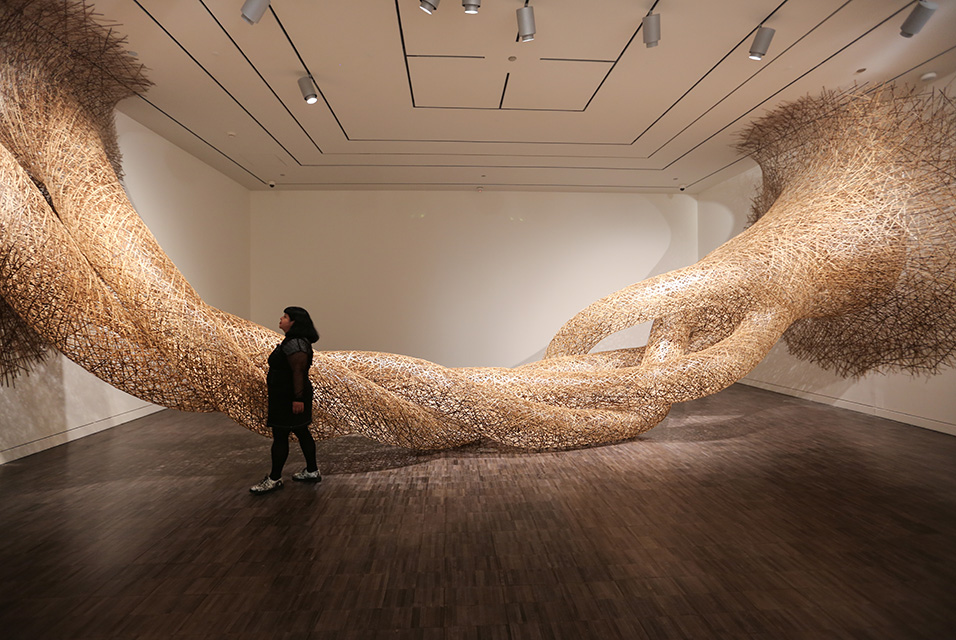Japanese master Tanabe Chikuunsai IV presents a spectacular bamboo installation at Asian Art Museum

artdaily_SAN FRANCISCO, CA.- The Asian Art Museum invites visitors to experience the grandeur and artistry of Connection, a soaring, site-specific bamboo sculpture that pushes the limits of this art form. Open May 31 to August 25, Connection will be only the second U.S. installation ever — and the largest— made by Tanabe Chikuunsai IV, who magnifies the scale of traditional Japanese basket-making techniques, weaving together past and present into astonishing, gallery-sized organic shapes that have captivated audiences across the globe.
Chikuunsai IV (pronounced, “Chee-kuh-oon-sye, the fourth”) creates dramatic, immersive environments that evoke the bamboo forests where these works began their lives. For this commissioned project at the Asian Art Museum, the artist and three apprentices from his studio in Japan will spend two weeks weaving strips of bamboo into a complexly textured, twisting shape that climbs to the gallery ceiling.
Born Tanabe Takeo in 1973, Chikuunsai comes from a renowned family of Japanese bamboo artists. He learned the techniques of bamboo weaving from his father Chikuunsai III and grandfather Chikuunsai II and the playful spirit of his art from his mother. He was bestowed with the artist name Chikuunsai, meaning “master of the bamboo clouds,” in 2017, securing the legacy of his family’s renowned mastery of bamboo. The title of this new sculpture, Connection , honors the deep bond he feels with his family lineage of bamboo artists
“Bamboo is more than a traditional craft material in Japan,” says Maya Hara, Japan Foundation Curatorial Assistant in Japanese Art at the Asian Art Museum and the curator of this exhibition. “It has figured prominently across the country’s art and literature for centuries. Bamboo’s ability to bend in the wind without breaking, while marking the subtle changes of nature over time, make it a cultural symbol of deep meaning.”
Chikuunsai IV’s artistic process for his installations begins when he selects the best stalks of rare tiger bamboo ( torachiku ), which grows only in the remote mountains of Kochi prefecture. He then cuts and splits the stalks into strips, which he bends and plaits into towering installations. Later he dismantles the works, carefully cleaning the bamboo strips to recycle into a new sculpture: the bamboo at the Asian Art Museum will be drawn from previous works in Paris (Musée Guimet), New York (The Metropolitan Museum of Art) and São Paulo, Brazil (Japan House). “By reusing the material, I wanted to express nature’s cycle of birth, that we are co-existing with nature,” explains Chikuunsai.
Connection also recognizes Chikuunsai’s long relationship with the Asian Art Museum and Lloyd Cotsen (1929–2017), a champion of Japanese bamboo art who generously donated his extensive collection to the museum in 2006. It was a competition sponsored by Cotsen in the early 1990s that solidified Chikuunsai’s resolve to follow in his family’s footsteps to become an artist. Although he did not win top prize that year, in 2007 he was awarded the Lloyd Cotsen Bamboo Prize. “In this way, San Francisco and the Asian Art Museum represent a starting point for me,” says the artist.
“In the midst of our major capital campaign and expansion project, Connection captures the essence of a transformed Asian Art Museum — at once innovative, immersive and intimate,” says museum Director and CEO Jay Xu. “The grand scale of the artwork, its abstract forms and the creative ingenuity underlying it contrasts powerfully with the natural materials and the artist’s references to age-old craft traditions. Connection shows what it truly means to ‘connect’ the past to the present in a way only our museum can.”
